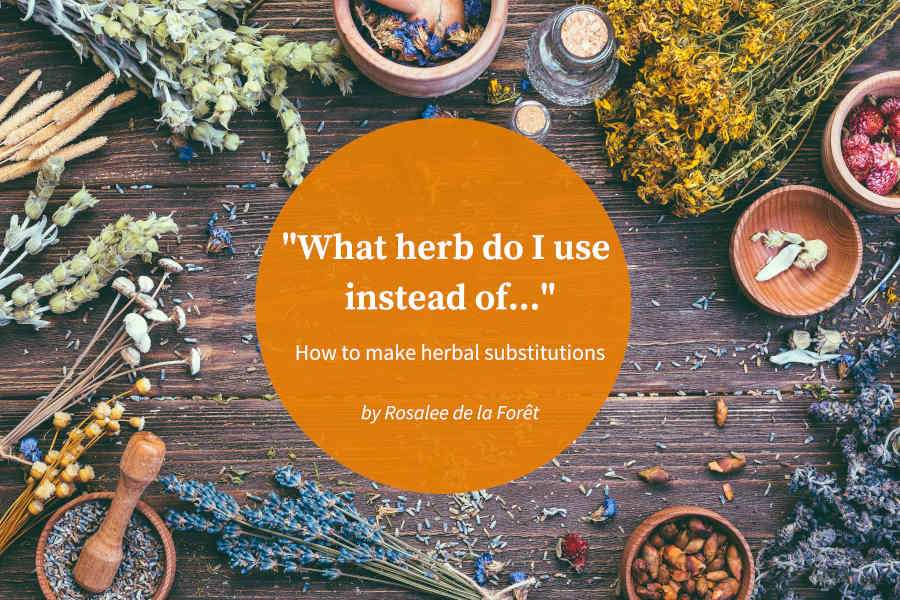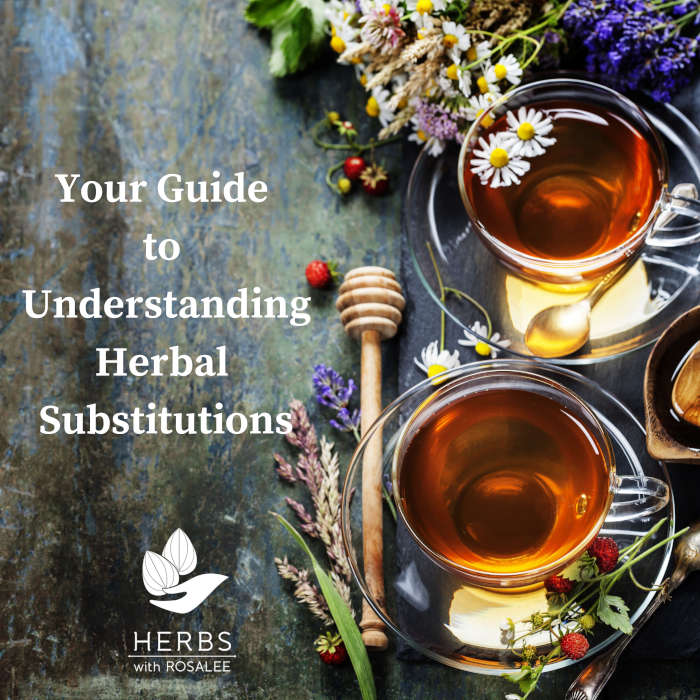Get weekly tips, recipes, and my Herbal Jumpstart e-course! Sign up for free today.

What Herb Can I Use Instead of…
Share this! |
|
“I’m allergic to chamomile, what can I use instead?”
“What works in place of lavender? It gives me migraines.”
“I hate the smell of rose. What other herb can be used?”
One of the most common questions I get is some version of, “What herbs can I use instead of ________?”
At first it may seem like a simple question; a simple this-for-that substitution. But the reality is, herbal substitutions are more complicated than that.
Believe me, if I could give you a simple reference chart that easily referenced what herbs to substitute with what, I would!
The reality is that, in order to make herbal substitutions, you need to know how to think about them first.
But before we go there, let’s look at why herbal substitutes are necessary.
Why Herbal Substitutions are Necessary
The reason for needing an herbal substitution can sometimes help you figure out the best substitute.
Dislike
Sometimes people and herbs simply don’t get along. Maybe it’s the taste (e.g., many people despise cilantro) or simply a deep seated general dislike of the plant. Either way I don’t often recommend taking herbs you are repulsed by.
Intolerances, Allergies or Unwanted Effects
Most herbs are safe for most people, but not all herbs are safe for all people. For example, it’s not uncommon for people to have sensitivity to the aster family and herbs like chamomile. (In that case, it’s important to find a substitute from a different family of plants entirely.)
Another issue is that there are some herbs that can have unwanted effects in certain populations. For example, licorice, when taken in large amounts, may increase blood pressure in sensitive people.
For others, special circumstances, such as during pregnancy or breastfeeding, inhibit the use of certain herbs for a certain amount of time only.
Lack of Availability (either short term or long term)
Sometimes people read about an herb and are excited about the benefits but aren’t able to find it near them. Other times people are eager to make a recipe, but are lacking an herbal ingredient. (Note: See my list of herbal farms and wildcrafters to see if there is someone selling herbs local to you. They may also have recommendations on local herbal substitutes.)
More and more, sustainability issues are also affecting the supply and, sometimes, herbs such as slippery elm are harder to find in commerce. (See a list by United Plant Savers showing at risk herbs.)
How to Think about Substitutions
The simple question of “What herb can I use instead of ______” is not so simple! Instead we need to know more about your intents and reasons for the herb or herbal formula.
1. What are you wanting to use the plant for?
Plants rarely have one virtue; as a result, we use them in a variety of ways.
Take garlic for example. It can be used for:
- promoting digestion
- inhibiting infections
- warding off a cold or flu
- relieving coughing and chest congestion
- for supporting heart health
- countless other uses!
So when someone asks me, “What can I use instead of garlic?” I’m honestly not sure! It depends on why they are using it. For example, hawthorn is also often used for heart health but I wouldn’t reach for it to inhibit a fungal infection or to stop a cold or flu.
It’s rare that there’s going to be a single herb that exactly matches all the uses of garlic. But, it’s likely that there is an herb (or herbs) that can do some of the same herbal actions.
In this case, it would be better to ask, “What herb can I use instead of garlic to address cholesterol levels?” or “What herb can I use instead of garlic to relieve coughing and chest congestion?” etc.
2. Don’t Forget Herbal Energetics, Taste (and Herbal Actions)
When deciding to use an herb based on outcome or disease it can result in an overwhelming list of choices. To get a taste of this try looking up “herbs for coughs”.
Thinking about a plant’s qualities of hot and cold and dry and damp can make substituting a lot easier.
For example, if you have a cough, determine if the cough is dry and spasmodic (therefore wanting a moistening and relaxing herb) or cold and congested (therefore wanting a warming and stimulating herb).
Another way you can think about this is with herbal actions. If you are needing to tighten and tone tissues with an astringent, you can think about the entire astringent rose family or other notably astringent plants.
Keeping herbal energetics in mind can also help you avoid poor substitutions. For example, if you are looking for an herb that is cooling, you can avoid choosing an herb that may work similarly but is too warming for the situation.
Taste is a wonderful way to help you match herbal energetics and choose herbal substitutions! For example, if you wanted to substitute an herb for skullcap for relieving stress and anxiety, you could look for other bitter relaxing nervines (say vervain).
3. Think About Herbal Formulas
When thinking about herbal substitutions, don’t be confined to choosing a single herb.
In some cases it’s best to create a formula from a variety of herbs to more closely match the herb you are looking for. For example, if someone tended to be cold and damp and they were wanting something instead of garlic for general heart health I might recommend hawthorn and rosemary. If someone was wanting a carminative/digestive herb instead of garlic I might recommend elecampane bitters.
4. What Herbal Remedy are Your Preparing? (and why)
Some herbs excel as teas or decoctions, others are preferred as alcohol extracts (tinctures).
When substituting herbs, consider if the herb you are substituting will work well with your particular herbal preparation.
Let’s say you’ve sprained your ankle. You know that arnica is helpful for ankle sprains but you don’t have any available. Arnica, when used as a whole herb, is most often used externally as a cream, liniment, salve, etc. External preparations make a lot of sense for acute and localized injuries. So when searching for another herb to help with the pain, consider how that herb might be best used. (Ideas: comfrey poultice, goldenrod infused oil, Kloss’ liniment, etc).
Sometimes you can decide how to prepare an herb based on its preferred use. However, when working within a recipe, sometimes you are more locked into a particular preparation and you’ll want to choose herbs that make sense with that. Again, using arnica as an example, I would recommend prickly ash internally for neuropathic pain, but I would not recommend arnica internally due to safety concerns.
Lastly, when making an herbal substitution, as a simple or as a formula, pay attention to dose as this can vary widely between plants.
Summing it Up
One time, while I was walking in the forest, I was stung multiple times by wasps. I desperately searched for plantain but couldn’t find any. However, growing all around me was lemon balm. I chewed it up, placed it over the hot swelling stings, and was amazed at how quickly the pain was reduced. Now I know that if plantain’s not available for an emergency insect sting, lemon balm can also work (and vice versa).
In other words, time and experience will also help guide you in figuring out substitutions.
In the meantime, if something has you stumped, consult with a person or references with the following in mind:
- Exactly what qualities are you looking for? Why do you need a particular herb?
- Consider taste, herbal energetics and actions to further guide you.
- How are you going to prepare it? Are you locked into a particular preparation?
- If one single herb isn’t an exact match, consider a two or three herb formulation to fully capture what you are looking for.

Rosalee is an herbalist and author of the bestselling book Alchemy of Herbs: Transform Everyday Ingredients Into Foods & Remedies That Healand co-author of the bestselling book Wild Remedies: How to Forage Healing Foods and Craft Your Own Herbal Medicine. She's a registered herbalist with the American Herbalist Guild and has taught thousands of students through her online courses. Read about how Rosalee went from having a terminal illness to being a bestselling author in her full story here.

